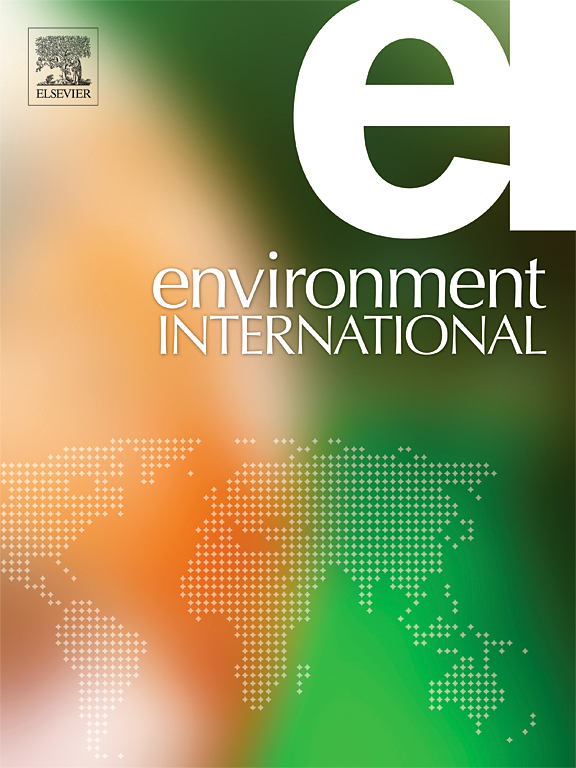产前接触邻苯二甲酸盐和替代增塑剂与儿童早期情绪和行为结果的环境影响对儿童健康结果(ECHO)队列
IF 10.3
1区 环境科学与生态学
Q1 ENVIRONMENTAL SCIENCES
引用次数: 0
摘要
有证据表明,产前接触邻苯二甲酸盐会对儿童的行为产生不利影响。然而,关于替代增塑剂的流行病学研究仍然很少。本研究调查了1.5-5岁 岁儿童孕期接触邻苯二甲酸酯和替代增塑剂与内化和外化行为的关系。方法纳入13个环境对儿童健康结局(ECHO)影响队列的2617对母子。主要收集妊娠中晚期产妇尿液样本,分析27种邻苯二甲酸酯代谢物和6种替代增塑剂代谢物。根据检测频率,对代谢物浓度进行连续或分类建模(1组:不可检测,2组:低可检测,3组:高可检测)。使用线性混合效应模型估计个体代谢物浓度与1½-5岁儿童行为检查表上的内化和外化t评分之间的协变量调整关联。同时还考察了儿童性别对效果的影响。结果与第1组相比,第3组邻苯二甲酸一苯酯(MBzP)和邻苯二甲酸一己酯(MHxP)的隶属度在四分位数范围内的增加与更高的外化t评分相关(β外值为连续MBzP = 0.53,95 % CI: 0.05, 1.00;MHxP组3 βext = 1.23,95 % CI: 0.35, 2.12)。我们观察到邻苯二甲酸酯代谢物与内化t评分之间没有明显的关联,环己烷-1,2-二羧酸单羧酸异辛酯(DINCH)代谢物与任何行为结果之间也没有明显的关联。儿童性别改变了几种代谢物与外化t评分之间的联系,尽管代谢物的影响方向各不相同。结论:这项大规模的研究表明,产前暴露于几种邻苯二甲酸盐,而不是另一种增塑剂DINCH,可能与幼儿外化行为的小幅至适度增加有关。本文章由计算机程序翻译,如有差异,请以英文原文为准。
Prenatal exposure to phthalates and alternative plasticizers and emotional and behavioral outcomes in early childhood in the Environmental influences on Child Health outcomes (ECHO) cohort
Background
Evidence suggests prenatal phthalate exposure adversely affects children’s behavior. However, epidemiological studies on alternative plasticizers remain scarce. This study investigated associations of gestational exposure to phthalates and alternative plasticizers with internalizing and externalizing behaviors in children aged 1.5–5 years.
Methods
The study included 2617 mother–child dyads from 13 Environmental influences on Child Health Outcomes (ECHO) cohorts. Maternal urine samples, primarily collected mid- to late-pregnancy, were analyzed for 27 phthalate metabolites and 6 alternative plasticizer metabolites. Based on detection frequency, metabolite concentrations were modeled either continuously or categorically (Group 1: non-detectable, 2: lower detectable, 3: higher detectable). Covariate-adjusted associations between individual metabolite concentrations and internalizing and externalizing T-scores on the Child Behavior Checklist for Ages 1½–5 were estimated using linear mixed-effects models. Effect modification by child sex was also examined.
Results
An interquartile range increase in mono-benzyl phthalate (MBzP) and membership in Group 3, versus Group 1, for mono-hexyl phthalate (MHxP) were associated with higher externalizing T-scores (βext for continuous MBzP = 0.53, 95% CI: 0.05, 1.00; βext for MHxP Group 3 = 1.23, 95% CI: 0.35, 2.12). We observed no robust associations between phthalate metabolites and internalizing T-scores, nor between cyclohexane-1,2-dicarboxylic acid mono carboxyisooctyl ester (DINCH) metabolites and any behavioral outcomes. Child sex modified associations between several metabolites and externalizing T-scores, although the direction of effect varied by metabolite.
Conclusion
This large-scale study suggests that prenatal exposure to several phthalates, but not to the alternative plasticizer DINCH, may be associated with a small-to-modest increase in externalizing behaviors in young children.
求助全文
通过发布文献求助,成功后即可免费获取论文全文。
去求助
来源期刊

Environment International
环境科学-环境科学
CiteScore
21.90
自引率
3.40%
发文量
734
审稿时长
2.8 months
期刊介绍:
Environmental Health publishes manuscripts focusing on critical aspects of environmental and occupational medicine, including studies in toxicology and epidemiology, to illuminate the human health implications of exposure to environmental hazards. The journal adopts an open-access model and practices open peer review.
It caters to scientists and practitioners across all environmental science domains, directly or indirectly impacting human health and well-being. With a commitment to enhancing the prevention of environmentally-related health risks, Environmental Health serves as a public health journal for the community and scientists engaged in matters of public health significance concerning the environment.
 求助内容:
求助内容: 应助结果提醒方式:
应助结果提醒方式:


